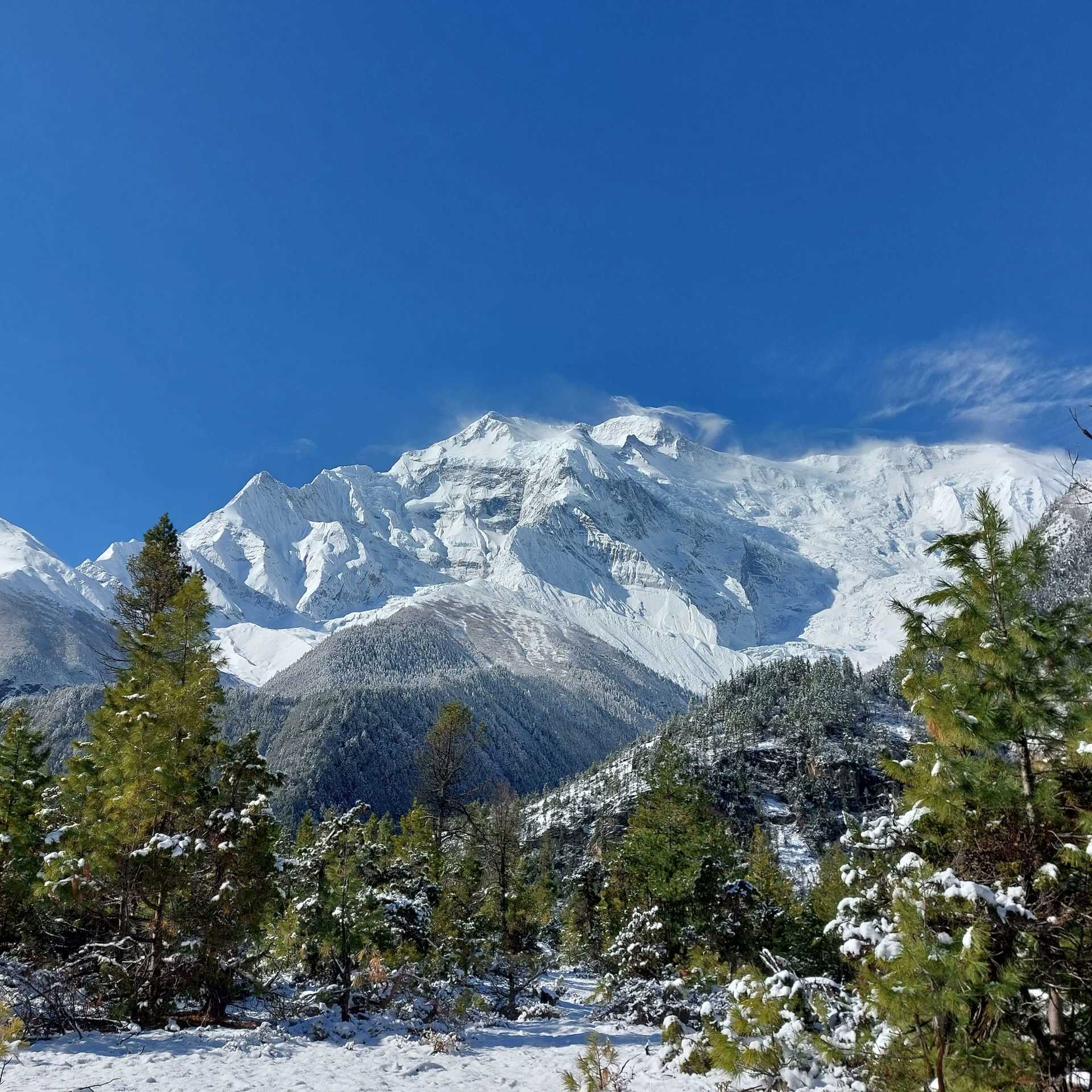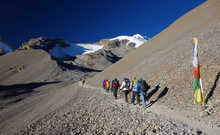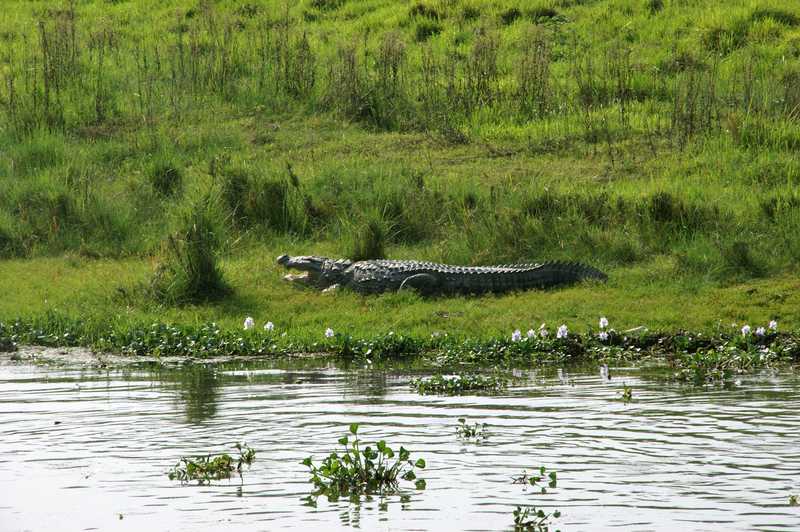Annapurna Circuit trek
- Kandoo Trekking

Contact
our UK team

All trekkers need to organise their own flights to Kathmandu International Airport (KTM). From Kathmandu Airport we will arrange a private transfer to your hotel. That night you will meet your local Kandoo representative and have a full pre-trek briefing.
We begin this trip driving along the Kathmandu-Pokhara Highway to Dumre and then following the rough road along the Marshyangdi River. After 6 hours we finally reach Besisahar, the capital of Lamjung District, and starting point of our trek. We begin the trek following the path to Pam Khola. On crossing the stream, we climb up towards the village of Denauti where we will see Nepali village life at close quarters; terraces stocked with tomato plants and potatoes spread out before us. As the trail nears the Khudi Khola, we reach the Gurung village of Bhulbhule.
A steep trail descends from Bhulbhule before crossing a stream. It then climbs again and traverses the hillside before reaching the village of Hani Gaon. We follow the winding mountain path down through Syange and along the river for some distance. The trail then climbs steeply and the path is cut into the sheer cliff-face some 200-300m above the river-bed. Eventually we descend to the village of Jagat, situated on a shelf that juts out into the Marshyangdi valley. As we descend towards the village the path is littered with Mica rocks, the minerals glistening in the Nepalese sun.
The trail from Jagat descends until it reaches the river and then continues through a lush forest, before ascending to a sharp-edged cliff facing the riverbank. After crossing a suspension bridge, we climb steeply on the path to Sattale and then to Tal. As we walk away from Tal, the path becomes rugged and winding and we pass the forested village of Karte and Dharepani before we finally reach Bagarchap. Annapurna II becomes visible as we arrive at Bagarchap, a Bhotia village with colourful prayer flags.
As we continue ascending through forests of pine and oak, we pass through Dhanakyu before coming to a large waterfall. Further on, the Marshyangdi River enters a gorge and the trail follows a rock-strewn path. When the steep incline ends, we follow a path amid rhododendrons and continue on a gently rising path. We cross a stream before entering a pine forest. We then enter the hamlet of Kotho, from where we can get a good view of Annapurna II. The route reaches a large white gate with a corrugated iron roof, which is the entrance of Chame, the administrative headquarters of Manang district. There is electricity, shops, health post, post office and banks in Chame. The hot springs are a major attraction too.
Today we head off for Pisang crossing a large suspension bridge over the Marshyangdi. Our trail meanders through fields leading to Teleku at 2775 metres before reaching Bratang. After leaving the forested village, the valley changes from a V-shape to a gentle U-shape. Further on, we continue up steep trails to the south side and cross a long suspension bridge at 3040 metres. From here we get to view Paungda Danda rising more than 1500 metres from the river. We cross one final bridge and enter the village of Pisang.
We start today heading along a steep ridge with wonderful views of the Manang valley and the Tilicho peak. We descend through Manang's airstrip to come to Hongde, lying beneath Annapurna III on the north-east face. The route then leads to the wide plain of the Sabje Khola Valley from where we get views of Annapurna IV (7525m). Further on, we cross a wooden bridge, and enter the village of Mungji. We continue along the cultivated fields and after a while arrive at the village of Bryaga which has a lovely monastery. On trekking down to Manang, we get more views of the Annapurna range - Annapurna II, Annapurna III, Annapurna IV, Gangapurna (7455m) and Tilicho Peak (7134m).
A day for rest and acclimatisation. Today we will trek up a further 300 metres to help your acclimatisation before returning to Manang.
Leaving Manang we cross a stream and climb to Tengi, 120 meters above Manang. We then ascend further past Marshyangdi Valley, turning up the valley of the Jarsang Khola. Here the vegetation of scrub juniper and alpine grasses marks the change in altitude, and with it, signs of buddhism becoming evermore present. We reach the small village of Gunsang, a cluster of flat mud roofs just below the trail at 3960 meters. The trail takes us further along a large stream that flows from Chulu Youst and Gunsang and leads to Letdar.
Leaving Letdar, we climb gradually to a ridge before descending to the headwaters of the Marshyangdi and crossing via a covered wooden bridge. After a short ascent up the path on the right bank, we follow a narrow trail across an unstable steep slope and then descend to Thorung High Camp.
We have an early start today, leaving at around 4:30am, for the crossing of Thorung La (5416m). The trail becomes steep immediately on leaving camp, but as local people have used this trail for hundreds of years, the path is well defined and marked with poles. The gradient then eases and after around 4 hours of steady climbing, we reach the prayer flags of the pass. From the snow-covered mountains above, to the head of the Kali Gandaki valley below and the brown and purple hills of Mustang, which spread out before us, we are presented with dramatic views. The descent to Muktinath is a tough 1600m. But the excellent views of Dhaulagiri are a good distraction. Eventually moraine gives way to grassy slopes before a pleasant walk along the Jhong Khola Valley to Muktinath, with its shrines and temple.
We now begin the descent down the dramatic Kali Gandaki valley, initially through arid country in the same geographical and climatic zone as Tibet. After passing through Jharkot and Khingar, villages with typical Tibetan architecture, we follow the valley floor most of the way to Jomsom. En route, we get tremendous views of both Dhaulagiri and Nilgiri. Jomsom is a large town sprawled along both banks of the Kali Gandaki River, and it is here we will spend the final night of our trek.
We take an early morning flight from Jomsom to Pokhara. Our accommodation is only a 5 minute walk from the airport but the kindness of the Nepalese people means our porters insist on helping us with our bags. It is a spectacular flight along the Kali Gandaki Gorge and provides wonderful views of both the Dhaulagiri and Annapurna ranges. We then catch a further flight back to Kathmandu.
We will collect you from your hotel and transfer you to Kathmandu Airport for your departing flight
In Kathmandu, if you choose to eat outside your hotel,
use your common sense when selecting where and what to eat, drink bottled water
and avoid ice in drinks.
The
room prices at the teahouses are based on you taking your meals within the
teahouse - they offer discounted room pricing on the expectation that they will
receive income from food. This is standard policy at all teahouses. You
therefore cannot eat outside the teahouse, and you definitely cannot bring your
own food into the teahouse.
Your
full day by day itinerary shows what is included in terms of hotel
accommodation and meal basis. All of our pre- and post-trek accommodation is
based in Kathmandu. Where your hotel basis is B&B, you can usually purchase
snacks or meals at the hotel, which can be paid in Nepali Rupees or US Dollars. Check in time will be between 12:00 and
2:00 pm, depending on the hotel. If you arrive on an early flight into
Kathmandu, you may have to wait until this time for your room to be available.
Similarly, if you return at the end of your trek on an early flight from Pokhara,
you will not be able to check into your room straight away.
The general standard of driving
throughout Nepal is poor and badly regulated. Roads in Kathmandu are very
congested, many drivers are not properly licensed and vehicles are poorly
maintained. During the monsoon season (June to September) many roads outside
the Kathmandu valley are prone to landslides and may become impassable.
We insist on using a high standard of
vehicle and driver for all of our transfers. In Nepal it is not a legal
requirement to have seatbelts fitted in the back of vehicles, and while we try
to use vehicles that do have rear seatbelts fitted, this cannot always be
guaranteed. If you are unhappy about any aspect of the vehicle or the standard
of driving, please speak to the driver or our local office immediately.
The internal flights from Jomsom
to Pokhara
and Pokhara
to Kathmandu operate an absolutely strict maximum limit of 10kg for your main
equipment bag and a maximum of 5kg for your day sack. Your baggage will be weighed by the airport staff so it is
important that you
do not exceed these limits.
The porters can carry up to 15kg in
the main equipment bag, so there is scope for
your bag to be slightly heavier while you are on the trek. However, you may
need to move items into your daysack for the flight out of Jomsom.
Duffel bags
You will be provided with a large duffel bag at the pre-trek briefing that will be yours to use for the duration of your trek. Your equipment will then need to be transferred into this bag. If you are travelling with a duffel bag then it is up to you which bag you choose to use for the trek, if you are travelling with a suitcase then this will need to be left at the pre-trek hotel and collected upon your return as our porters need the bags they carry to be flexible.
If you are relying on a credit or debit card for emergency funds, make sure you tell your card issuer that you will be using it abroad, or you may find that it won't work when you really need it.
We
realise that tipping may not be a common practice in all countries but for
Nepal it is a standard practice that all operators support. The decision on how
much to tip should be determined by how well the team served you while you were
on the trek. Tips are always discretionary and if you are not happy with the
service you have received you do not have to pay tips. Tips can be made in US
dollars or Nepali Rupees. It is very important that US bills be new (less than 10 years old), crisp and untorn.
We
are members of the Trekking Agencies Association of Nepal and the Nepal
Mountaineering Association, and follow their guidelines when recommending tip
levels for guides and porters. We would suggest you budget $125-$175 per
trekker for your tip contribution.
We
say goodbye to our porters in Jomsom before we return to Kathmandu. Any tips
that you wish to give to the porters will need to be carried on the trek with
you.
Duffel bags
You will be provided with a large duffel bag at the pre-trek briefing that will be yours to use for the duration of your trek. Your equipment will then need to be transferred into this bag. If you are travelling with a duffel bag then it is up to you which bag you choose to use for the trek, if you are travelling with a suitcase then this will need to be left at the pre-trek hotel and collected upon your return as our porters need the bags they carry to be flexible.
Most
of the rental shops close around 8pm, so if you are arriving on a late flight
the day before the trek starts there will not be an opportunity for you to
visit a rental store. If you are planning on renting equipment, you need to
make sure you have allowed sufficient time at the beginning of your trip.
All
rental equipment is included in your overall trekking bag weight, so make
sure you have allowed for this when packing your bag at home. A sleeping bag
will weigh around 2kg.
UPPER
BODY
LEGS
OTHER
ACCESSORIES
| From | To | Price | Availability | Book | Enquire |
|---|---|---|---|---|---|
| 05/05/2024 | 18/05/2024 | £1,379 $1,795 |
Available
|
Book now | Enquire now |
| 12/05/2024 | 25/05/2024 | £1,379 $1,795 |
Available
|
Book now | Enquire now |
| 19/05/2024 | 01/06/2024 | £1,329 $1,725 |
Available
|
Book now | Enquire now |
| 26/05/2024 | 08/06/2024 | £1,329 $1,725 |
Guaranteed
|
Book now | Enquire now |
| 01/09/2024 | 14/09/2024 | £1,329 $1,725 |
Available
|
Book now | Enquire now |
| 08/09/2024 | 21/09/2024 | £1,329 $1,725 |
Available
|
Book now | Enquire now |
| 22/09/2024 | 05/10/2024 | £1,329 $1,725 |
Available
|
Book now | Enquire now |
| 06/10/2024 | 19/10/2024 | £1,379 $1,795 |
Guaranteed
|
Book now | Enquire now |
| 20/10/2024 | 02/11/2024 | £1,379 $1,795 |
Available
|
Book now | Enquire now |
| 27/10/2024 | 09/11/2024 | £1,379 $1,795 |
Available
|
Book now | Enquire now |
| 10/11/2024 | 23/11/2024 | £1,379 $1,795 |
Available
|
Book now | Enquire now |
| 17/11/2024 | 30/11/2024 | £1,329 $1,725 |
Available
|
Book now | Enquire now |
| 24/11/2024 | 07/12/2024 | £1,329 $1,725 |
Available
|
Book now | Enquire now |
| 01/12/2024 | 14/12/2024 | £1,329 $1,725 |
Available
|
Book now | Enquire now |
| 09/02/2025 | 22/02/2025 | £1,379 $1,795 |
Available
|
Book now | Enquire now |
| 23/03/2025 | 05/04/2025 | £1,429 $1,855 |
Available
|
Book now | Enquire now |
| 30/03/2025 | 12/04/2025 | £1,429 $1,855 |
Available
|
Book now | Enquire now |
| 13/04/2025 | 26/04/2025 | £1,429 $1,855 |
Available
|
Book now | Enquire now |
| 20/04/2025 | 03/05/2025 | £1,429 $1,855 |
Available
|
Book now | Enquire now |
| 04/05/2025 | 17/05/2025 | £1,429 $1,855 |
Available
|
Book now | Enquire now |
| 11/05/2025 | 24/05/2025 | £1,429 $1,855 |
Available
|
Book now | Enquire now |
| 18/05/2025 | 31/05/2025 | £1,379 $1,795 |
Available
|
Book now | Enquire now |
| 25/05/2025 | 07/06/2025 | £1,379 $1,795 |
Available
|
Book now | Enquire now |
| 31/08/2025 | 13/09/2025 | £1,379 $1,795 |
Available
|
Book now | Enquire now |
| 07/09/2025 | 20/09/2025 | £1,379 $1,795 |
Available
|
Book now | Enquire now |
| 21/09/2025 | 04/10/2025 | £1,379 $1,795 |
Available
|
Book now | Enquire now |
| 05/10/2025 | 18/10/2025 | £1,429 $1,855 |
Available
|
Book now | Enquire now |
| 19/10/2025 | 01/11/2025 | £1,429 $1,855 |
Available
|
Book now | Enquire now |
| 26/10/2025 | 08/11/2025 | £1,429 $1,855 |
Available
|
Book now | Enquire now |
| 09/11/2025 | 22/11/2025 | £1,429 $1,855 |
Available
|
Book now | Enquire now |
| 16/11/2025 | 29/11/2025 | £1,379 $1,795 |
Available
|
Book now | Enquire now |
| 23/11/2025 | 06/12/2025 | £1,379 $1,795 |
Available
|
Book now | Enquire now |
| 30/11/2025 | 13/12/2025 | £1,379 $1,795 |
Available
|
Book now | Enquire now |
Want to ask us a question or book a private trip? Don't hesitate to contact us!
Contact us